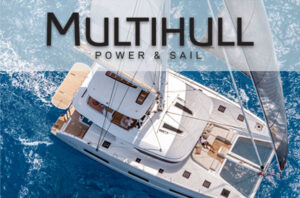For more multihull reviews and stories, subscribe for free to Multihull Power & Sail

When my editor assigned this story, I promised myself not to use the worn, old cliché, “A boat is a hole in water into which you pour money.”
Oops. There, I said it.
And I wasn’t going to mention robber baron J.P. Morgan’s famous quote, “Anyone who has to ask about the annual upkeep of a yacht can’t afford one.”
Oops again.
Full disclosure: I have owned more boats than I want my wife or my banker to know about. I therefore have a PhD in the costs of boats. So, here’s my take.
Lots of sources say you should budget about 10% of the boat’s cost on maintenance. BS flag raised on that one.
First, there are so many variables to consider. Is it new? Is it old? Is it decrepit? Since we’re talking modern multihulls, it’s likely to be fiberglass, but does it have wood trim to maintain? How many engines? Generator? Trying to nail a single percentage is hopeless; it’s like asking how much a car costs. So, let’s take a look at some things that affect the equation.
New or Used: This is simple. A new boat costs more, but it has less maintenance. It also has warranties, not just from the builder but on all the systems from engines to refrigerator. Bigger investment up front, less annual costs. Your call.
Keeping It: You have to stash it somewhere, and that can vary from a municipal marina (usually cheapest) to a private marina to a yacht club (most expensive). You’ll pay by the foot, either monthly or annually.
Dockage is like real estate: location, location, location. The closer you are to the harbor entrance, the more you’ll pay. And the convenience of stepping from a dock rather than going out to a mooring will also affect the bottom line.
Winter: As a Californian transplanted to Florida, I don’t have to deal with freezing winters. But if you live in a colder climate, your boat will need to be hauled out and winterized at shipyard labor rates with storage fees.
Maintaining It: This is usually the biggest item, since your boat will need bottom paint—fiberglass is not the “maintenance-free” material once touted—and your systems, from engines to air conditioning, need servicing.

If your attitude is to pick up the phone and call for a repair when something breaks on your car or at home, stop reading right here. DIY is not only the purview of Home Depot, but of West Marine and all the other marine stores that will sell you everything you need to maintain your boat.
Maintenance is also the mantra of smart boat owners, but you must do it. If you want to hire someone to wash your boat weekly and scrub the barnacles off the bottom, then that’s obviously more expensive. But if you aren’t afraid of a scrub brush and some suds, you’ll save money. That applies to every part of a boat: the more you can do, the less it will cost you. As the former owner of a mahogany boat that was varnished from top to bottom, I know of what I speak. To be honest, though, I’d rather pay a pro crew to buff my fiberglass hull (it’s a pain), but I’ll do my own varnish because I like the satisfaction of sanding and the aroma of varnish.
One Absolute Caswellian Law: If you don’t maintain it, it will cost more.
Insuring It: This is going to vary depending on your declared value, at about 1.5%. More expensive boat, more insurance costs. It’s a straight line. You may be able to save a bit by moving your boat out of the “hurricane zone” in the season, and a little more by trimming your coverages to the basics, especially if you’re hauled out for months during the winter. Find a good insurance broker and have a heart-to-heart chat.
Running: Every boat larger than a beach cat has engines (that includes a generator) and some have sails. Today’s sails last a long time (unless you do something stupid), but engines require maintenance, usually every 100 hours for oil, filters, etc.
My experience suggests that diesel versus gas costs are about the same. Diesel engines cost more initially, and diesel fuel is pricier, but the engines last longer. Gas brings the possibility of a big bang.
Sailing multihulls reduce their fuel costs by sailing, but buyers of power cats could serve themselves well by checking the fuel consumption numbers before signing the contract. As a professional boat tester, I am sometimes startled by how much (or how little) equally sized boats consume in fuel. Know before you buy.
Systems: Years ago when I started boating (when dinosaurs roamed the earth), we didn’t have what we now call systems. No A/C, electric toilets, electric winches, or chartplotters. It was a simpler time, and less expensive. The more systems you have, the higher your maintenance costs. Period.
Smart Moves: Before you buy, walk the boat shows, explore the boat dealerships. At a boat show, you may find that the Super Duper Chartplotter you want is available in different versions and at different prices from several electronics shops. Invest shoe leather to save money. And don’t pay for bells and whistles you don’t need.
Shop wisely: I learned a valuable lesson when I had a Porsche decades ago. I found that a chrome Porsche lug nut ($29) was identical to a Volkswagen lug nut ($5). When you’re fitting out with all the boat gear, from lifejackets to fishing rods, first aid kits to water toys, remember that big box stores (Costco/Sam’s) may have the same items for less. Putting the word “boat” or “marine” in front of a product is sometimes the same as a Porsche lug nut.
OSIF: This category is lifted from my wife, She Who Must Be Obeyed, who owned two French restaurants and whose catering budgets always included the line item “OSIF”: “Oh, S**T, I Forgot.” It’s the little nickel-and-dime stuff you forget. For boats, it might be the annual registration sticker, replacing worn docklines, or the not-cheap can of polish for the chrome and stainless. It adds up.
I’ll leave you with a thought: No self-respecting accountant can sharpen a pencil and make the numbers “work” for boat ownership. They always require some unrecoverable investment. But being on the water—at the end of a week filled with deadlines, traffic jams, and ringing phones—remains our dream of adventure and freedom, of a warm breeze and the sound of a bow wave, that can’t be justified just in dollars.
For more multihull reviews and stories, subscribe for free to Multihull Power & Sail
MHP&S Summer 2024








